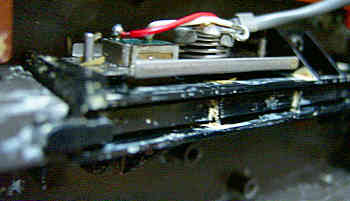| squarewave keyboard with Playcard slot & key lighting |
This instrument from 1984 was Yamaha's smallest key lighting keyboard with Playcard System (see Yamaha PC-100). Unlike PC-100, the sound generator here is simple squarewave and resembles MC-3.
The PCS-30 has officially only each 6 OBS preset sounds and rhythms, but by a Playcard trick you can select some more. There is also a simple single finger accompaniment. Beside less features, the behaviour and sound of this instrument is almost identical with the newer Yamaha PSS-160, thus I only describe here the differences.
 |
 |
 |
 |

This is the tape head. |
hardware detailsIn spite of the many similarities with the PSS-160, the hardware of the PCS-30 is far more complicated and employs a separate RAM and ROM IC; the ICs have even function names printed on the PCB. The main CPU is marked "Z80" and the type "TMPZ84C00P" indeed hints to the Toshiba CMOS DIL version of the Zilog Z80 CPU. This may make it easier to reverse-engineer and emulate the PlayCard data format. How ever the ROM has a strange pinout (like eprom 2764, but additional A13 on pin 26, A14 on pin 22).ROM Yamaha YM2211-22712:
Vcc 1 +-v-+ 28 Vcc
A14 of the ROM is connected with A15 of the CPU. A14 of the CPU goes to the special IC YM3514 instead. I first even thought it was copy protected, because when read in an adapter as eprom 27C010, the resulting 4 copies in the 128KB dump were (unlike expected by the lack of A15, A16) not identical, but contained sections of varying regular bit patterns those looked like generated by internal counters or such stuff. (Verifying the dump worked, thus the counter seemed to reset by reading from start.) But it turned out that this ROM simply needs pulldown resistors at the data lines to prevent crosstalk from address lines and then reads normal as 32KB. The keyboard has a sheet metal frame like known from other old Yamahas. (I haven't analyzed the hardware further yet.) pinout YM2142 (GE8)The Yamaha YM2142 (24 pin DIL) is the "GE8" digital squarewave sound IC, that was used in cheap (toy grade) Yamaha home keyboards. The IC is 4 note polyphonic with linear envelope (with a little zipper noise and end click) and blip percussion using 2 additional percussion waveforms (semi-metallic and shift-register feedback noise hiss). It can re-route polyphony channels to switch them among main and chord voice outputs. This sound IC is very similar but not identical with Yamaha YM2163 (thus see there for info). The waveforms look very similar but pinout differs, because it e.g. can additionally generate a tempo clock signal from a potentiometer input and control a tempo LED. Further differences are unknown.The YM2142 was used at least in Yamaha PCS-30, PSS-150 and PSS-160. I was told by Saien Mado that swapping it with YM2163 in Yamaha
PSS-160 makes no sound at all. This pinout is based on excerpts
of the PSS-160 schematics. Although pin names differ, most have an equivalent
in YM2163. In said schematics the YM2142 is also referred "YM21420", which
may be an alternative name of it.
|
My specimen from eBay fortunately came with a big stack of additional Playcards from multiple different looking sets (see here), those also work with my other Playcard System keyboards. Some cards show an "arpeggio" slider setting, but unlike Yamaha PC-100, the PCS-30 has neither arpeggio nor this slider. I later bought 2 further PCS-30 with additional Playcards.
The demo mode is hidden so deeply that it is almost an easteregg; I had to read the manual to discover its existence. To start a demo song, hold down one of the rightmost 3 white keys (their note will sound) and push 'auto play' for normal demo playback; if you want to train it in free tempo mode, push 'free tempo' instead. The demos load into RAM like normal Playcard songs and thus can be controlled with the usual buttons. The demos are well made (with obligato and standard accompaniment) but unfortunately quite short. The demo 'B' is the same tune like with Casio MT-800 (but much shorter).
A 44 midsize keys variant of the PCS-30 was released as Yamaha PC-50
(same case style in white with transposer knob). But possibly it belongs
to another hardware class, because the preset sounds {organ, violin, clarinet,
piano, harpsichord, vibraphone} and rhythms {march, waltz, slow rock, jazz
rock, swing, rhumba} are named differently and rightmost keys lack demo
letters.
| removal of these screws voids warranty... | ||
 |
||
|
|